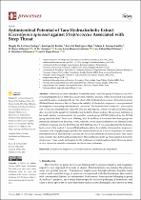| dc.contributor.author | De La Cruz-Noriega, Magaly | |
| dc.contributor.author | Benites, Santiago M. | |
| dc.contributor.author | Rodríguez-Haro, Icela M. | |
| dc.contributor.author | Salazar-Castillo, Marco L. | |
| dc.contributor.author | Rojas-Villacorta, W. | |
| dc.contributor.author | Otiniano, N. M. | |
| dc.contributor.author | Becerra-Gutiérrez, Lizzie Karen | |
| dc.contributor.author | Cabanillas-Chirinos, Luis | |
| dc.contributor.author | Mendoza-Villanueva, K. | |
| dc.contributor.author | Rojas-Flores, S. | |
| dc.date.accessioned | 2023-11-02T15:20:18Z | |
| dc.date.available | 2023-11-02T15:20:18Z | |
| dc.date.issued | 2023-06-08 | |
| dc.identifier.uri | https://hdl.handle.net/20.500.13067/2743 | |
| dc.description.abstract | Antibiotics are often prescribed to treat infections caused by group B Streptococcus; however, inappropriate use of antibiotics can develop resistance. Because of this, the research was carried out with the aim of evaluating the in vitro effect of the hydroalcoholic extract of Caesalpinia spinosa (Molina) Kuntze known as Taya or Tara on the viability of β-hemolytic streptococci; an experimental investigation of increasing stimulation was carried out. The hydroalcoholic extract of C. spinosa pods was worked in concentrations of 250, 500, 750, and 1000 mg/mL, which were placed on filter paper discs to perform the sensitivity test following the Kirby–Bauer method. The greatest inhibition of bacterial viability was observed in the penicillin control group (GPT-01) followed by the TCT-04 group (hydroalcoholic Tara extract 1000 mg/mL). In addition, it was found that these groups are statistically different from the rest (p < 0.05), while the lowest bacterial inhibition was obtained for the erythromycin group and the TCT-01 group (250–1000 mg/mL). It was concluded that the hydroalcoholic extract of the pods of C. spinosa (Molina) Kuntze affects the viability of β-hemolytic streptococci associated with strep pharyngitis and that this antimicrobial activity is due to the presence of tannins, steroidal flavonoid, and alkaloids. Likewise, the tested concentrations of hydroalcoholic Tara extract were found to have better antibacterial activity than erythromycin (15 µg/mL) against β-hemolytic streptococci. These results are hopeful for the traditional or herbal medicine field. However, future in vivo research is needed to determine its effectiveness in humans. | es_PE |
| dc.format | application/pdf | es_PE |
| dc.language.iso | eng | es_PE |
| dc.publisher | MDPI | es_PE |
| dc.rights | info:eu-repo/semantics/openAccess | es_PE |
| dc.rights.uri | https://creativecommons.org/licenses/by/4.0/ | es_PE |
| dc.subject | β-hemolytic streptococci | es_PE |
| dc.subject | Caesalpinia spinosa | es_PE |
| dc.subject | Erythromycin | es_PE |
| dc.subject | Strep throat | es_PE |
| dc.title | Antimicrobial Potential of Tara Hydroalcoholic Extract (Caesalpinia spinosa) against Streptococcus Associated with Strep Throat | es_PE |
| dc.type | info:eu-repo/semantics/article | es_PE |
| dc.identifier.journal | Processes | es_PE |
| dc.identifier.doi | https://doi.org/10.3390/pr11061754 | |
| dc.subject.ocde | https://purl.org/pe-repo/ocde/ford#2.07.00 | es_PE |
| dc.source.volume | 11 | es_PE |
| dc.source.issue | 2023 | es_PE |
| dc.source.beginpage | 1 | es_PE |
| dc.source.endpage | 11 | es_PE |


